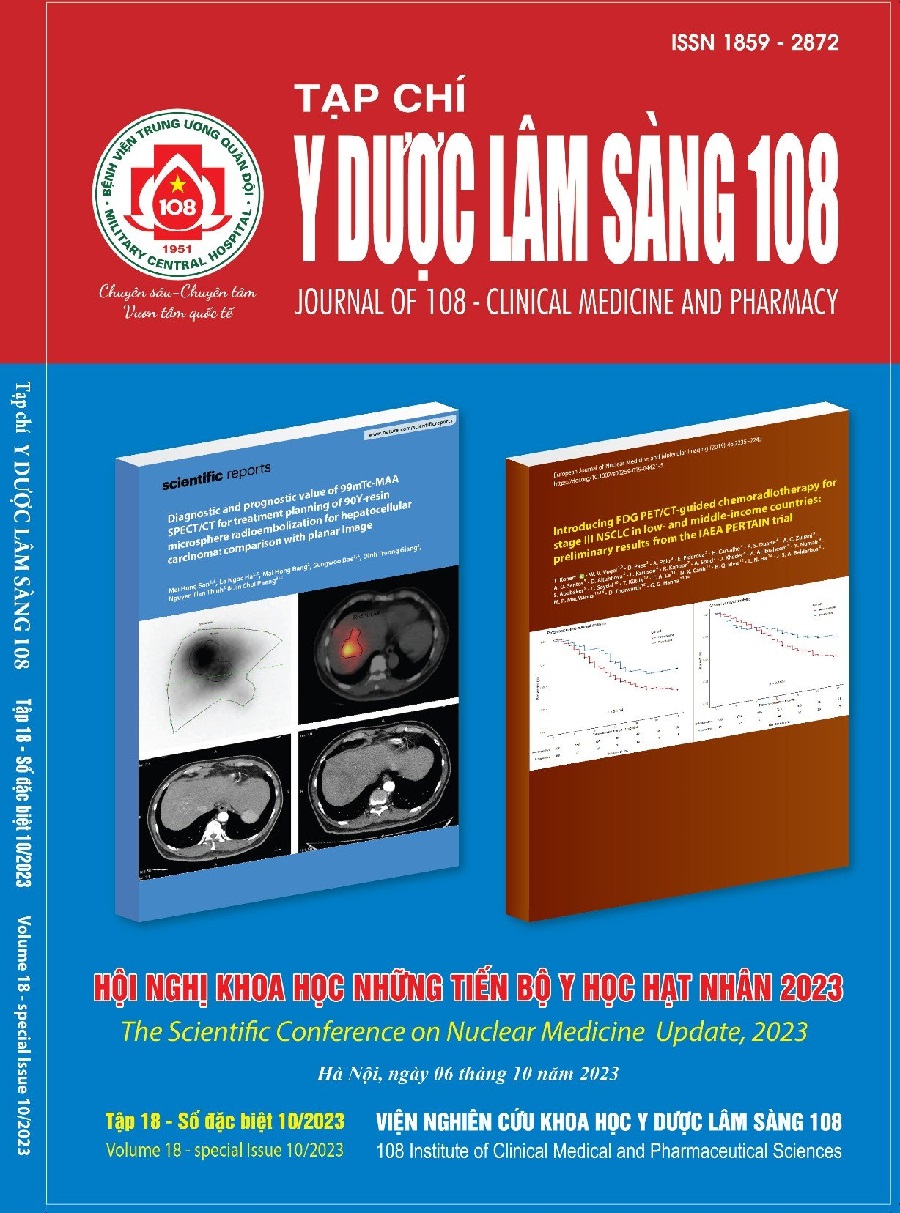Relationships between 18F-FDG PET/CT metabolic parameters and progression-free survival in radioiodine refractory differentiated thyroid cancer
Main Article Content
Keywords
Abstract
Objective: To investigate the relationship of metabolic 18F-FDG PET/CT parameters with progression - free survival (PFS) in patients with radioiodine refractory differentiated thyroid cancer patients. Subject and method: 85 radioiodine refractory differentiated thyroid cancer patients with recurrent/metastatic lesions detected in 18F-FDG/PET/CT were included in our study. The highest standardized uptake value (SUVmax and SUVpeak) of the lesions, total MTV (metabolic tumor volume) and total TLG (total lesion glycolysis) were measured. Curves of progression-free survival (Kaplan-Meier) and Cox univariate and multivariate analyses determined the prognostic factors. Result: The mean values of the highest SUVmax and SUVpeak, total TLG, and total MTV were 11.94 ± 12.6g/ml; 7.03 ± 8.9g/ml; 39.16 ± 100.6g/ml ´ cm3; 5575 ± 14327mm3, respectively. 45/85 (52.9%) patients had disease progressed during follow-up with a median progression-free survival (PFS) of 8.5 months (4.8-57.3 months). PFS was higher in patients with SUVpeak < 4.59g/ml, TLG < 6.34g/ml ´ cm3, MTV < 1699mm3. In the univariate analysis, highest SUVpeak, total MTV, total TLG were significantly associated with PFS. In multivariate analysis, total MTV, total TLG were independent prognostic factors of PFS. Conclusion: Metabolic parameters of 18F-FDG PET/CT could be used as prognostic factors of disease progression in radioiodine refractory differentiated thyroid cancer patients.
Article Details
References
2. Haddad RI, Bischoff L, Ball D, Bernet V, Blomain E, Busaidy NL, Campbell M, Dickson P, Duh QY, Ehya H, Goldner WS, Guo T, Haymart M, Holt S, Hunt JP, Iagaru A, Kandeel F, Lamonica DM, Mandel S, Markovina S, McIver B, Raeburn CD, Rezaee R, Ridge JA, Roth MY, Scheri RP, Shah JP, Sipos JA, Sippel R, Sturgeon C, Wang TN, Wirth LJ, Wong RJ, Yeh M, Cassara CJ, Darlow S (2022) NCCN Clinical Practice Guidelines in Oncology - Thyroid Carcinoma. J Natl Compr Canc Netw 20(8): 925-951. doi: 10.6004/jnccn.2022.0040.
3. Haugen BR, Alexander EK, Bible KC, Doherty GM, Mandel SJ, Nikiforov YE, Pacini F, Randolph GW, Sawka AM, Schlumberger M, Schuff KG, Sherman SI, Sosa JA, Steward DL, Tuttle RM, Wartofsky L (2016) 2015 American Thyroid Association Management Guidelines for adult patients with thyroid nodules and differentiated thyroid cancer: The American Thyroid Association Guidelines task force on thyroid nodules and differentiated thyroid cancer. Thyroid 26(1): 1-133.
4. Worden F (2014) Treatment strategies for radioactive iodine-refractory differentiated thyroid cancer. Ther Adv Med Oncol 6(6): 267-279. doi: 10.1177/1758834014548188.
5. Caetano R, Bastos CR, de Oliveira IA, da Silva RM, Fortes CP, Pepe VL, Reis LG, Braga JU (2016) Accuracy of positron emission tomography and positron emission tomography‐CT in the detection of differentiated thyroid cancer recurrence with negative 131I whole‐body scan results: A meta‐analysis. Head Neck 38(2): 316-327.
6. Masson-Deshayes S, Schvartz C, Dalban C, Guendouzen S, Pochart JM, Dalac A, Fieffe S, Bruna-Muraille C, Dabakuyo-Yonli TS, Papathanassiou D (2015) Prognostic value of 18F-FDG PET/CT metabolic parameters in metastatic differentiated thyroid cancers. Clinical Nuclear Medicine 40 (6).
7. Manohar PM, Beesley LJ, Bellile EL, Worden FP, Avram AM (2018) Prognostic value of FDG-PET/CT metabolic parameters in metastatic radioiodine refractory differentiated thyroid cancer. Clin Nucl Med 43(9): 641.
8. Lodi Rizzini E, Repaci A, Tabacchi E, Zanoni L, Vicennati V, Cavicchi O, Pagotto U, Morganti AG, Fanti S, Monari F (2021) Impact of 18F-FDG PET/CT on clinical management of suspected radio-iodine refractory differentiated thyroid cancer (RAI-R-DTC). Diagnostics (Basel) 11(8): 1430.
9. Wang H, Dai H, Li Q, Shen G, Shi L, Tian R (2021) Investigating 18F-FDG PET/CT parameters as prognostic markers for differentiated thyroid cancer: A systematic review. Front Oncol. 11:648658. doi: 10.3389/fonc.2021.648658.
10. Mai Hồng Sơn N. T. N., Nguyễn Thanh Hướng, Lê Duy Hưng, Lê Ngọc Hà (2018) Bước đầu nghiên cứu giá trị của 18F-FDG PET/CT trong đánh giá đáp ứng sớm điều trị sorafenib ở bệnh nhân ung thư tuyến giáp biệt hóa kháng 131I. Tạp chí Y dược lâm sàng 108, 13(7), tr. 51-60.
11. GE healthcare (2012) PET VCAR User guide. General Electric Company.
12. Lalchandani UR, Sahai V, Hersberger K, Francis IR, Wasnik AP (2019) A radiologist's guide to response evaluation criteria in solid tumors. Current Problems in Diagnostic Radiology 48(6): 576-585.
13. Rendl G, Schweighofer-Zwink G, Sorko S, Gallowitsch HJ, Hitzl W, Reisinger D, Pirich C (2022) Assessment of treatment response to lenvatinib in thyroid cancer monitored by F-18 FDG PET/CT Using PERCIST 1.0, Modified PERCIST and EORTC Criteria-Which One Is Most Suitable?. Cancers (Basel) 14(8): 1868.
14. Albano D, Tulchinsky M, Dondi F, Mazzoletti A, Lombardi D, Bertagna F, Giubbini R (2021) Thyroglobulin doubling time offers a better threshold than thyroglobulin level for selecting optimal candidates to undergo localizing [18F]FDG PET/CT in non-iodine avid differentiated thyroid carcinoma. Eur J Nucl Med Mol Imaging. 48(2): 461-468.
15. Robbins RJ, Wan Q, Grewal RK, Reibke R, Gonen M, Strauss HW, Tuttle RM, Drucker W, Larson SM (2006) Real-time prognosis for metastatic thyroid carcinoma based on 2-[18F] fluoro-2-deoxy-D-glucose-positron emission tomography scanning. J Clin Endocrinol Metab 91(2): 498-505.
 ISSN: 1859 - 2872
ISSN: 1859 - 2872
